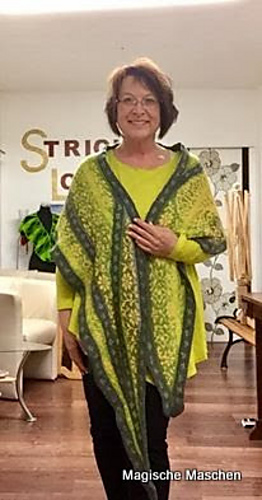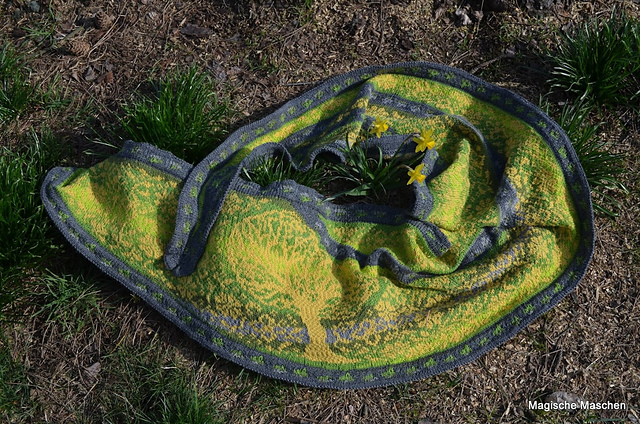
Doe Waka is a shawl for advanced (Swing-) knitters.
http://www.ravelry.com/patterns/library/doe-waka
Doe Waka is a long, asymmetrically shaped, crescent shaped shawl. It combines elements of Swing-Knitting™ and Colorwork.
Doe Waka is completely charted, so you can knit it without any prior knowledge of Swing-Knitting® – additional information for Swing-Knitters is added to each segment in a colored box.
All techniques that might not be known by everyone, are explained in detailed photo tutorials in a technical appendix.

Size: Approx. 240 cm long, 36 cm wide at its widest point
Material: I have knitted Doe Waka with sports weight wool of 320m /100 g and needle size 3.5 mm.
2 x 100 g main yarn = main color (MC) for the stanzas and coordinated color (CC) for the pauses:
Ferner Merino Baby, color 454
2 x 50 g CC for stanzas (yellow)
Ferner Merino 160, color 411
4 x 50 g MC for pauses (dark grey)
Ferner Merino 160, color 403
The finished shawl has a weight of 383 g, there will be leftovers of every color.
Please take care that the colors you use show enough contrast! Compare the colors of the variegated yarn with the light-colored solid yarn for the stanzas, and compare the variegated yarn and the dark solid for the pauses! Only if they show enough contrast, you will be able to clearly see the flowers and the tree – I did not succeed to 100% with my Doe Waka color choice !

Gauge in Stockinette stitch and colorwork with needle size 3.5 mm (after blocking):
22 stitches and 36 rows = 10 x 10 cm
If you knit the shawl with thinner yarn (and smaller needles), it will become smaller.
If you knit the shawl with thicker yarn (and larger needles), it will become larger and you’ll need more yarn.
You will need additionally:
At least 2 circular knitting needles 3.5 mm – 150 cm long
Several additional needles 3.5 mm
2 long additional needles 3.0 mm or smaller for the final border
2 closed stitch markers
For Swing-Knitters: light and dark safety pins

Colorwork (working with two colors in one row) – that’s a header for all those techniques that work with two yarns in two colors in one row. Fair Isle, Norwegian, Islandic patterns and more terms are included in Colorwork – the size of the two-colored patterns and the origins of the charts lead to different names.
I have drawn the charts for this shawl free, and I only used two traditional flower patterns within.
This shawl uses a pattern rapport only within the pauses (the dark areas) above the stanzas (areas built with short rows), the stanzas were drawn free.

The shawl combines Colorwork with short rows – therefore you can’t knit the Colorwork traditionally in rounds, it has to be knitted in rows.
I have added another PDF to this pattern, “How I knit Fair Isle in rows”. It describes in detail how I knit Fair Isle in rows. Every step includes a written description and a short video.
EVERY technique that leads to a similar result, is “correct”!!!!!
- If you feel good having floats on the back side of a shawl – do it!
- If you lead the two yarns in a different way – do it!

Doe Waka – that’s how this shawl got its name:
While I was knitting on it, I often thought of an old ear worm, I hummed it with every stylized daffodil that I knitted onto the flower field:
https://www.youtube.com/watch?v=dlMItetT1dI
The refrain of this canon “Doe Waka“ haunted me until I decided that the shawl had got its name .

You can ask questions and make remarks in our Ravelry group http://www.ravelry.com/groups/knitting-the-swing—swing-knittingtm – and please show us lots of photos!
This is the thread for Doe Waka:
http://www.ravelry.com/discuss/knitting-the-swing—swing-knittingtm/3626659/1-25







